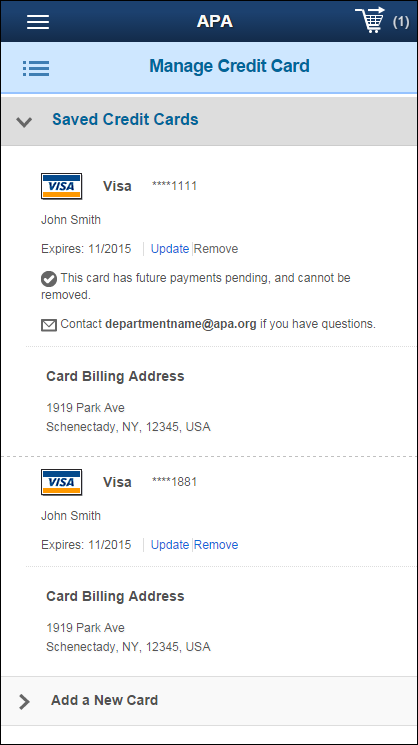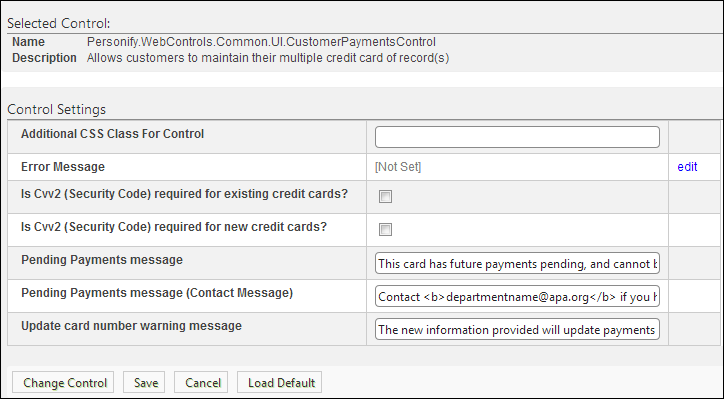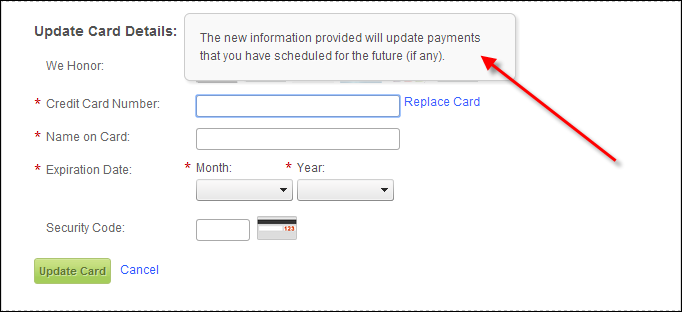Configuring the Web Settings for the Saved Credit Card Control
It is up to each client to determine the appropriate location of this
page, and to create the menu item that will lead web users to this page.
This a standalone control, which means that it has its own individual
value and does not require another control in order for it to function.
For more information, refer to the Standalone
Controls section.
See also:
· For an
overview of this control, please see the Saved
Credit Cards Control Overview.
· To see a video demonstration
of how the Saved Credit Cards control works on the web, please see Video
Demo: Working with Multiple Saved Credit Cards on the Web.
 As of 7.6.0, this control can be configured
to be responsive to mobile
users. After adding the responsive CSS to this page, your mobile phone
user will see the control on the responsive page similar to the one shown
below. For more information
about using this control on a responsive page, please see Making
a Page Responsive.
As of 7.6.0, this control can be configured
to be responsive to mobile
users. After adding the responsive CSS to this page, your mobile phone
user will see the control on the responsive page similar to the one shown
below. For more information
about using this control on a responsive page, please see Making
a Page Responsive.

To configure the web settings for the Saved Credit
Card control:
1. Add the
"CustomerPaymentsControl" to the desired page. For more
information, please see Adding
a .NET Web Control to a Page.
The following Control Settings display, as shown below. For detailed information
on each setting, please see the table below.

2. Configure the control
settings, as necessary. See below for a detailed description of each setting.
3. Click Save.
Parameter |
Description |
Additional CSS Class for Control |
This option allows you to add additional
layout to the skin by developing a new DOTNETNUKE style, which
requires an advanced understanding of HTML and CSS. |
Error Message |
If left blank and the "PersonifyErrorMessage"
do not return a result, the default error message, "An error
occurred while performing [Insert Action]. If the problem persists,
please contact the site administrator", will display. If
you wish to change the default error message, customize it with
a PWF parameter. See Setting
Up PWF Parameters for more information. |
Is Cvv2 (Security Code) required for existing
credit cards? |
Check this checkbox if a credit card
security code is required when replacing an existing credit card.
This value is not stored in the system, so web users will have
to re-enter this code for purchases even if the credit card is
saved on file.
 The IGNORE_CVV
merchant
parameter must also be set to "N" and the REJECT_CVV_RESULT_CODES interface
parameter for your payment handler must be set to "NULL".
If so, if the credit card security number is NOT entered, the
following error message will display: Your
credit card cannot be charged at this time. You may have left
the CVV2 number blank. Please try again making sure you entered
the correct CVV2 number. The IGNORE_CVV
merchant
parameter must also be set to "N" and the REJECT_CVV_RESULT_CODES interface
parameter for your payment handler must be set to "NULL".
If so, if the credit card security number is NOT entered, the
following error message will display: Your
credit card cannot be charged at this time. You may have left
the CVV2 number blank. Please try again making sure you entered
the correct CVV2 number.
|
Is Cvv2 (Security Code) required for new
credit cards? |
Check this checkbox if a credit card security
code is required when creating new credit cards. This value is
not stored in the system, so web users will have to re-enter this
code for purchases even if the credit card is saved on file.
 The IGNORE_CVV
merchant
parameter must also be set to "N" and the REJECT_CVV_RESULT_CODES interface
parameter for your payment handler must be set to "NULL".
If so, if the credit card security number is NOT entered, the
following error message will display: Your
credit card cannot be charged at this time. You may have left
the CVV2 number blank. Please try again making sure you entered
the correct CVV2 number. The IGNORE_CVV
merchant
parameter must also be set to "N" and the REJECT_CVV_RESULT_CODES interface
parameter for your payment handler must be set to "NULL".
If so, if the credit card security number is NOT entered, the
following error message will display: Your
credit card cannot be charged at this time. You may have left
the CVV2 number blank. Please try again making sure you entered
the correct CVV2 number.
|
Pending Payments message |
This message displays below a saved credit
card that has future pending payments notifying the web user that
it cannot be removed from the web. For example:
 |
Pending Payment message (Contact Message) |
This message displays the "Pending
Payments message" and should contain contact information
for the web user to contact your organization to remove the credit
card if necessary. For example:
 |
Update card number warning message |
This message displays when a web user
places his/her cursor in the Credit Card Number field, as shown
below. The purpose of this message is to notify the web user that
the new information provided will update payments that he/she
has scheduled for the future (if any).
 |
 As of 7.6.0, this control can be configured
to be responsive to mobile
users. After adding the responsive CSS to this page, your mobile phone
user will see the control on the responsive page similar to the one shown
below. For more information
about using this control on a responsive page, please see Making
a Page Responsive.
As of 7.6.0, this control can be configured
to be responsive to mobile
users. After adding the responsive CSS to this page, your mobile phone
user will see the control on the responsive page similar to the one shown
below. For more information
about using this control on a responsive page, please see Making
a Page Responsive.

 The
The 

